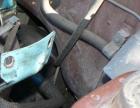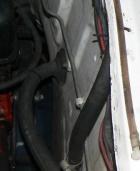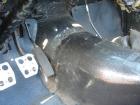Automatic-equipped cars had a significantly larger front tunnel area. The rear of the tunnel is the same. For this reason you can easily convert an Auto car to a Manual car. Going to automatic you, may need to modify the tunnel.
If you convert your originally automatic 1200 to a manual, you will notice that you have barely any room between the gas and brake pedals and you have to do tip-toe driving to make it work.
Replace the auto pedals with its larger brake pedal with the standard setup that has small brake pedal and clutch pedal.
- 'Bridge' the start inhibit wires that go to the auto gearbox
- Replace the spacer in pedal box with clutch pedal (requires removal of dash and pedal box)
- Knock out the clutch firewall hole blanking plate
- In manual cars there are nuts welded from factory on the inside but autos don't. You can either put bolts and nuts thru the holes or weld some
- Install clutch cable
- Engine: remove flex plate and spacer
- add pilot bushing (if not already fitted)
- add flywheel, clutch disc and pressure plate
- Mount: either weld new mounts in or make a new crossmember
- Replace gearbox and auto tailshaft with manual versions
The speedo cable is the same.
Gearbox mounts are different, but is the shifter hole in the tunnel is in the same place (the rear portion of the tunnel is the same).
Contents |
Shifter
Shifter came with a console.
Driveshaft
The automatic has a larger spline. So use the auto driveshaft with auto transmission. Remember that B110 and B210 Driveshaft is the same. The B210 and B110 driveshafts are the same length. Only automatic vs manual lengths are different.
Rear Engine Mount
The rear engine mount, also called the "transmission crossmember" is mounted about six inches further back.
Part Numbers
Rubber Mount
- 11321-H1000 ASSY-INSULATOR ENGINE MOUNTING REAR Manual trans
- 11321-H1020 ASSY-INSULATOR ENGINE MOUNTING REAR Manual trans
Crossmember
- 11322-H1002 MEMBER-ENGINE MOUNTING REAR Manual
- 11322-H1020 MEMBER-ENGINE MOUNTING REAR Automatic
NOTE: B210 parts number are different from B110, but reportedly fit the same.
Engine Differences
Carburetor
For emission controls, the carb differed. However you can use any carb with an automatic.
Distributor
Auto cars had a different distributor curve for emission control. However you can use any distributor with an automatic.
Clutch Fittings
Automatic cars don't have:
- Clutch pedal
- Clutch master cylinder (LHD models)
- Clutch cable (RHD models)
These parts can be swapped from a manual car.
Starter Motor
Starter for automatic transmission differs from starter for manual transmission. But otherwise A12 & A14 starters interchange.
Flex Plate
Automatics don't use a flywheel, the torque convertor has enough mass to act as the flywheel. They use a thin "flex plate" with has the ring gear teeth for the starter.
Also note the crankshaft adapter.
You can use the flywheel off the A14 on the A15. The thing to look at is the back of your A15's crankshaft -- make sure it has the hole for the trans pilot shaft bearing.
Crankshaft
the A-14 engine with an automatic has a lip on the end of the crankshaft that might have to be ground down with a grinder to mate to the manual tranny. Then you will be set to mate them together.
Kick down Switch
Check around the top of the throttle pedal, with autos there should be either a bracket for the kick down switch,or maybe the switch is still there
Tunnel
The Auto body has seperate tunnel and floor. The tunnel is spot welded in. The seam is clearly noticeable on the firewall at the back of the engine.
Manual body has one piece floor and tunnel, no joins whatsoever. Bellhouseing part of tunnel is one piece with firewall.
Wiring
Check the engine wiring loom to see if there is prevision for the auto inhibitor switch. This prevents the engine from being started unless the auto is in P or N (park or neutral)

![[Datsun 1200 encyclopedia]](/wiki/upload/wiki.png)



